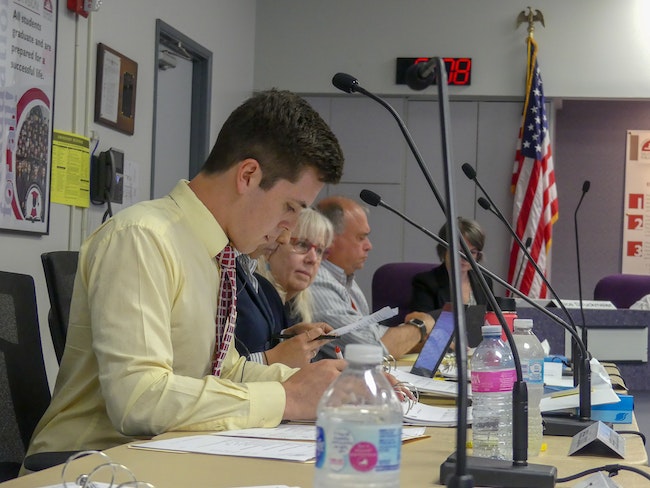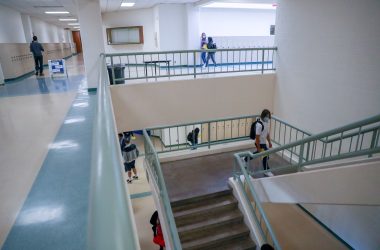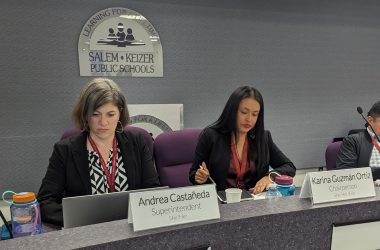
School board member Jesse Lippold at a spring 2019 meeting of the Salem-Keizer budget committee (Rachel Alexander/Salem Reporter)
Four years ago, Jesse Lippold Peone and Levi Herrera-Lopez ran against each other for an open seat representing southeast Salem on the Salem-Keizer School Board.
Now, the two have found an area of agreement. Both support a plan to change how the board is elected.
Currently, the school district is divided into seven geographic zones. Board directors must live in the zone they represent, but are elected by voters across the district, which spans two cities and two counties.
Under the proposed change, voters in each zone would elect their own representative. That means Lippold Peone, who won his 2017 race, would only have to campaign in southeast Salem.
It’s a change advocates say would reduce the cost of running, encourage more diverse candidates to seek office and ultimately help elect a board that better reflects the people it serves.
“You dig a deep well in your own community instead of a shallow pool across town,” Lippold Peone said of the proposal, which he first put forward at a Jan. 12 board meeting.
On Tuesday, the board will consider Lippold Peone’s plan and could vote to adopt it.
Whether a new election system will be in place in time for the upcoming May election depends on the timeline adopted by the board.
Lippold Peone wants to move quickly. His seat is one of four up for election, and Lippold Peone is the only sitting board member who has filed to run for another term.
He said the task of diversifying the board is too urgent to wait.
The four people elected in May will hold a majority of the board’s seven seats and take office at a critical time. The district expects to be emerging from the pandemic, while facing continued calls to remove police from schools and do more to address educational inequities for students of color.
Board Chair Satya Chandragiri, who was elected in 2019, said he supports the move to zoning but on extended timeline. He plans to introduce an amendment to the proposal which would set a spring 2022 deadline for the process. He wants to pair the move to zoned elections with a required redrawing of zone boundaries which will take place after Census data is published. That process should be nonpartisan and include community hearings, Chandragiri said.
“Whatever we do should last 20, 30 years. We need to define it, codify it. It should be beyond my lifetime,” he said.
In previous meetings, other board members have expressed concern about the timeline for the proposal, with Vice Chair Danielle Bethell and Marty Heyen saying they wanted to allow more time for public engagement.
Board member Kathy Goss said she doesn’t believe zoning elections would reduce the influence of special interest groups. She said special interests have dominated the Salem City Council, despite elections being zoned, citing the council’s 2019 vote against building a third bridge across the Willamette River.
A changing district
It’s the first time the school board has considered a change, but the issue of how board members are elected has been a regular topic of discussion among community organizers in recent years.
Jim Green, executive director of the Oregon School Boards Association and a former Salem-Keizer board member, said the issue wasn’t raised a decade ago when the board redrew zone boundaries following the 2010 Census.
In the years since, the district has grown more diverse, but not uniformly.
Students are 42% Latino, but the board has never had a Latino representative. Latino residents are concentrated in north and east Salem, particularly in zone 5, which Lippold Peone represents, and zone 2, represented by Marty Heyen, who won reelection in 2019 against challenger Raul Marquez, a recent McKay High School graduate.
Lippold Peone said having elections by zone instead of district wide wouldn’t alone have changed the outcome of the 2019 races, citing data presented to the board by the Mid-Willamette Valley Council of Governments. Those numbers show Heyen won her zone in addition to the at-large vote, as did Chandragiri, who defeated David Salinas in a close race.
But Lippold Peone and Herrera-Lopez said moving to a zoned system would change the way board candidates campaign, allowing them to focus on winning over their neighbors rather than an area the size of three combined Oregon Senate districts.
Herrera-Lopez said in his 2017 campaign against Lippold Peone, he wanted to reach out to less-active voters, mostly Latino, who don’t typically participate in off-year elections. That meant not only convincing them to vote for him but letting them know an election was taking place and reminding them to turn ballots in before the deadline.
“If you’re building the plane while you’re flying, that makes it much more expensive,” he said.
Green said under the current system, board members are incentivized to campaign by reaching out to voters who regularly vote in off-year elections, when turnout is low. In 2019, just 19% of registered Marion County voters and about 30% of Polk County voters cast a ballot in board races.
“If you can figure out the precincts or the zones in which people have really voted in the last school board elections, you don’t even have to target where you live, you target those people,” he said.
Green said other Oregon districts take multiple approaches to board elections. In rural districts where finding enough candidates to run for open seats can be a challenge, electing board members at-large makes sense, he said.
But he believes Salem-Keizer should move to zones because of the district’s large size, the differences in the racial and socioeconomic makeup of zones, and the way recent elections have become politically polarized and expensive.
Board members should campaign by getting out and talking to neighbors in their zone, he said, rather than trying to run a campaign across two cities.
“You ought to have a sense of community,” he said.
Oregon voting rights
In 2019, the Oregon Legislature passed a voting rights act backed by Pineros y Campesinos Unidos del Noroeste, Oregon’s farmworker union, which has been a major contributor to local board campaigns in recent years.
PCUN ran campaigns for Marquez and Salinas, and the group’s operations director, Maria Hinojos Pressey, has filed to run for the zone 7 seat in May.
The law specified that school district elections can’t be conducted in a way that dilutes the votes of a protected class, including a racial or ethnic group, by denying them the chance to select their own representatives.
“We were passing it with the intention of using it in the Salem-Keizer School District,” said Reyna Lopez, PCUN’s executive director.
Lopez said she’s glad to see Lippold Peone taking up the issue but wants to ensure Salem-Keizer follows the process outlined in the Voting Rights Act, which requires at least two public hearings before implementing changes. She’s doubtful the board could solicit and respond to public input in time to change the process for May elections.
“I would love for something to get done quickly but at the same time I’m a big believer that process really matters,” she said.
Oregon Right to Life, another major donor to school board campaigns, said they don’t support changing the system without more public outreach.
“We support reducing barriers for community members to serve in these important positions. There needs to be a sufficient period for voters to understand the proposal and give feedback,” said Reagan Knopp, the group’s political director, in an email. He declined to elaborate on whether the group supported the concept of zoned elections.
Chandragiri said he authored his amendment after reading the Voting Rights Act and listening to a community forum about Lippold Peone’s plan hosted last week by the Salem-Keizer NAACP.
He said the act and forum convinced him zoned elections make sense, but he wants to make sure the board takes time to create a robust, nonpartisan election system.
Lippold Peone said he believes the public supports the change and has been urging people to contact school board members ahead of Tuesday’s meeting. He said he’s frustrated it’s taken nearly two months since he first introduced the plan for the board to begin seeking community input.
“I’m just trying to make sure that our board has an open mind and is going to listen to people,” he said.
Update: This article was updated on March 9 at 11 a.m. to change Jesse Lippold’s name to Jesse Lippold Peone, reflecting his recent legal name change, and to clarify his frustrations on the timeline of the proposal.
To participate: The virtual meeting takes place at 6 p.m. Tuesday, March 9 and will be live-streamed on YouTube in English and Spanish, and on CC Media, channel 21. The board is only considering written public comment and will not take live calls during the meeting. The board closed the form for comments at noon Monday to allow board members time to read all comments. Contact information for school board directors is available on the district website.
Contact reporter Rachel Alexander: [email protected] or 503-575-1241.
Salem Reporter counts on community support to fund vital local journalism. You can help us do more.
SUBSCRIBE: A monthly digital subscription starts at $5 a month.
GIFT: Give someone you know a subscription.
ONE-TIME PAYMENT: Contribute, knowing your support goes towards more local journalism you can trust.

Rachel Alexander is Salem Reporter’s managing editor. She joined Salem Reporter when it was founded in 2018 and covers city news, education, nonprofits and a little bit of everything else. She’s been a journalist in Oregon and Washington for a decade. Outside of work, she’s a skater and board member with Salem’s Cherry City Roller Derby and can often be found with her nose buried in a book.









